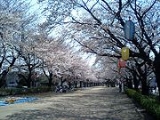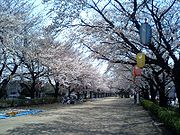
Fujimino, Saitama
Encyclopedia
is a city located in Saitama
, Japan
, about 30 km from central Tokyo. The city is surrounded by Kawagoe
, Fujimi
, and Miyoshi
.
The city is served by Kami-Fukuoka Station
, about 35 minutes on the Tōbu Tōjō Line from Ikebukuro Station
in Tokyo. Confusingly, Fujimino Station
is located in the neighbouring city of Fujimi
.
The Kan-Etsu Expressway passes through the west of the city, but there is no interchange.
and the town of Ōi
, from Iruma District
.
The first housing estates (Uenodai and Kasumigaoka) in Japan were built in Kamifukuoka (now Fujimino) city after the Second World War.
There used to be a military factory near Kamifukuoka City Hall in the 1940s.
Earthenwares from the Kamifukuoka shell mound in the Early Jōmon Period
, Sekiyama type, were discovered beneath the Dainihon Print Company.
Gongennyama claster of tumuli(Gongenyama mounded claster)built in early kofun
period, late 3rd century.
There is a Yakushi Buddha (Buddha of Healing) at the Yakuo Temple, which was maybe made in the Muromachi Period
.
in autumn.
. You can see Mount Fuji
from the riverside. If you go across the Yoro Bridge, you can see an old warehouse now called the Fukuokagashi Riverside Heritage Hall. It dates from the 1870s.
used to go falconing.

(Star) Festival and the Oi Festival.
drumming.
portable shrines and a parade of floats. You can also enjoy Yosakoi
dancing by dancers with naruko clappers in their hands. There are also many outdoor snack bars.
The Saty shopping mall has a multi-screen cinema, Ito Yokado supermarket, and a DIY centre, Viva. Viva sells many kinds of hobby and DIY things.
The first outlet shopping mall in Japan was built in Fujimino. It is called Rism, near Fujimino Station
. It has many designer shops.
Saitama Prefecture
is a prefecture of Japan located in the Kantō region of the island of Honshu. The capital is the city of Saitama.This prefecture is part of the Greater Tokyo Area, and most of Saitama's cities can be described as suburbs of Tokyo, to which a large amount of residents commute each day.- History...
, Japan
Japan
Japan is an island nation in East Asia. Located in the Pacific Ocean, it lies to the east of the Sea of Japan, China, North Korea, South Korea and Russia, stretching from the Sea of Okhotsk in the north to the East China Sea and Taiwan in the south...
, about 30 km from central Tokyo. The city is surrounded by Kawagoe
Kawagoe, Saitama
is a city located in Saitama Prefecture, Japan, and is about a 30-minute train ride from Ikebukuro in Tokyo.As of July 1, 2011, the city has an estimated population of 343,926...
, Fujimi
Fujimi, Saitama
is a city located in Saitama Prefecture, Japan.As of March 31, 2011, the city has an estimated population of 107,459 and a population density of approximately 5,454.77 persons per km²...
, and Miyoshi
Miyoshi, Saitama
is a town located in Iruma District, Saitama, Japan.As of 2003, the town has an estimated population of 36,587 and a density of 2,391.31 persons per km². The total area is 15.30 km².-External links:*...
.
The city is served by Kami-Fukuoka Station
Kami-Fukuoka Station
is a railway station in Fujimino, Saitama, Japan, operated by Tobu Railway.-Lines:Kami-Fukuoka Station is served by the Tōbu Tōjō Line from in Tokyo, with some services inter-running via the Tokyo Metro Yūrakuchō Line to and the Tokyo Metro Fukutoshin Line to...
, about 35 minutes on the Tōbu Tōjō Line from Ikebukuro Station
Ikebukuro Station
is a railway station located in the Ikebukuro district of Toshima, Tokyo, Japan. With 2.71 million passengers on an average daily in 2007, it is the second-busiest train station in the world , and the busiest station in the Tobu, Seibu and Tokyo Metro networks. It primarily serves commuters from...
in Tokyo. Confusingly, Fujimino Station
Fujimino Station
is a railway station in Fujimi, Saitama, Japan, operated by Tobu Railway.-Lines:Fujimino Station is served by the Tōbu Tōjō Line from in Tokyo, with some services inter-running via the Tokyo Metro Yūrakuchō Line to and the Tokyo Metro Fukutoshin Line to...
is located in the neighbouring city of Fujimi
Fujimi, Saitama
is a city located in Saitama Prefecture, Japan.As of March 31, 2011, the city has an estimated population of 107,459 and a population density of approximately 5,454.77 persons per km²...
.
The Kan-Etsu Expressway passes through the west of the city, but there is no interchange.
History
Fujimino City was formed on October 1, 2005, with the merger of the old city of KamifukuokaKamifukuoka, Saitama
was the name of a city located in Saitama Prefecture, Japan.On October 1, 2005, Kamifukuoka merged with the town of Ōi in Iruma District to form the new city of Fujimino....
and the town of Ōi
Oi, Saitama
was the name of a town located in Iruma District, Saitama, Japan.On October 1, 2005 Ōi was merged with the old city of Kamifukuoka to form the new city of Fujimino....
, from Iruma District
Iruma District, Saitama
is a district located in Saitama Prefecture, Japan.In the 2005 census reports, the district has an estimated population of 89,552. The total area is 89.77 km².The district consists of three towns:*Miyoshi*Moroyama*Ogose-District timeline:...
.
The first housing estates (Uenodai and Kasumigaoka) in Japan were built in Kamifukuoka (now Fujimino) city after the Second World War.
There used to be a military factory near Kamifukuoka City Hall in the 1940s.
Earthenwares from the Kamifukuoka shell mound in the Early Jōmon Period
Jomon period
The is the time in Japanese prehistory from about 14,000 BC to 300 BC.The term jōmon means "cord-patterned" in Japanese. This refers to the pottery style characteristic of the Jōmon culture, and which has markings made using sticks with cords wrapped around them...
, Sekiyama type, were discovered beneath the Dainihon Print Company.
Gongennyama claster of tumuli(Gongenyama mounded claster)built in early kofun
Kofun
Kofun are megalithic tombs or tumuli in Japan, constructed between the early 3rd century and early 7th century. They gave their name to the Kofun period . Many of the Kofun have a distinctive keyhole-shaped mound , unique to ancient Japan...
period, late 3rd century.
There is a Yakushi Buddha (Buddha of Healing) at the Yakuo Temple, which was maybe made in the Muromachi Period
Muromachi period
The is a division of Japanese history running from approximately 1336 to 1573. The period marks the governance of the Muromachi or Ashikaga shogunate, which was officially established in 1338 by the first Muromachi shogun, Ashikaga Takauji, two years after the brief Kemmu restoration of imperial...
.
Education
There are eight kindergartens, twelve elementary schools, six junior high schools, two high schools, and one university (Bunkyo University).Public facilities
There are two libraries, two public swimming pools (summer season only), and a number of public halls and community centres.Benten-no-mori Park
This is a nice park, which has a spring and a small temple. You can see cherry blossom in spring, and kudzuKudzu
Kudzu is a plant in the genus Pueraria in the pea family Fabaceae, subfamily Faboideae. It is a climbing, coiling, and trailing vine native to southern Japan and southeast China. Its name comes from the Japanese name for the plant, . It is a weed that climbs over trees or shrubs and grows so...
in autumn.
Shingashi River
The Shingashi River was used for transporting goods in the Edo PeriodEdo period
The , or , is a division of Japanese history which was ruled by the shoguns of the Tokugawa family, running from 1603 to 1868. The political entity of this period was the Tokugawa shogunate....
. You can see Mount Fuji
Mount Fuji
is the highest mountain in Japan at . An active stratovolcano that last erupted in 1707–08, Mount Fuji lies about south-west of Tokyo, and can be seen from there on a clear day. Mount Fuji's exceptionally symmetrical cone is a well-known symbol of Japan and it is frequently depicted in art and...
from the riverside. If you go across the Yoro Bridge, you can see an old warehouse now called the Fukuokagashi Riverside Heritage Hall. It dates from the 1870s.
Green Park
This is on the side of the Shingashi River. It is where Tokugawa IeyasuTokugawa Ieyasu
was the founder and first shogun of the Tokugawa shogunate of Japan , which ruled from the Battle of Sekigahara in 1600 until the Meiji Restoration in 1868. Ieyasu seized power in 1600, received appointment as shogun in 1603, abdicated from office in 1605, but...
used to go falconing.

Festivals
There are two big festivals in this city: the Kamifukuoka TanabataTanabata
is a Japanese star festival, originating from the Chinese Qixi Festival. It celebrates the meeting of the deities Orihime and Hikoboshi . According to legend, the Milky Way separates these lovers, and they are allowed to meet only once a year on the seventh day of the seventh lunar month of the...
(Star) Festival and the Oi Festival.
Kamifukuoka Tanabata Festival
This is a lively festival held on the first Saturday and Sunday of August every year since more than 50 years ago. It includes a bamboo decoration contest, Awa Odori dancing, Bon Odori dancing, and traditional taikoTaiko
means "drum" in Japanese . Outside Japan, the word is often used to refer to any of the various Japanese drums and to the relatively recent art-form of ensemble taiko drumming...
drumming.
Oi Festival
Oi Festival is held in the middle of July every year. You can see historic mikoshiMikoshi
A is a divine palanquin . Shinto followers believe that it serves as the vehicle to transport a deity in Japan while moving between main shrine and temporary shrine during a festival or when moving to a new shrine...
portable shrines and a parade of floats. You can also enjoy Yosakoi
Yosakoi
Yosakoi is a unique style of dance that originated in Japan. Yosakoi started in the city of Kōchi in 1954, as a modern rendition of Awa Odori, a traditional summer dance. Yosakoi-style dancing has spread throughout much of Japan. The style of dance is highly energetic, combining traditional...
dancing by dancers with naruko clappers in their hands. There are also many outdoor snack bars.
Shopping
Many supermarkets have been built in Fujimino in the last 10 years, including Ito Yokado, Yaoko, and Belc.The Saty shopping mall has a multi-screen cinema, Ito Yokado supermarket, and a DIY centre, Viva. Viva sells many kinds of hobby and DIY things.
The first outlet shopping mall in Japan was built in Fujimino. It is called Rism, near Fujimino Station
Fujimino Station
is a railway station in Fujimi, Saitama, Japan, operated by Tobu Railway.-Lines:Fujimino Station is served by the Tōbu Tōjō Line from in Tokyo, with some services inter-running via the Tokyo Metro Yūrakuchō Line to and the Tokyo Metro Fukutoshin Line to...
. It has many designer shops.

